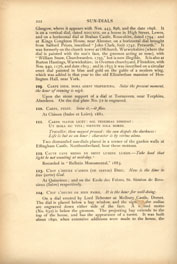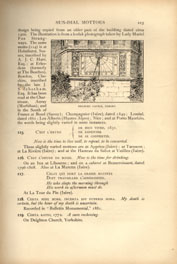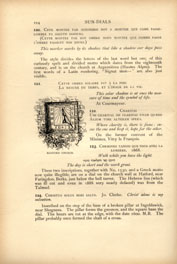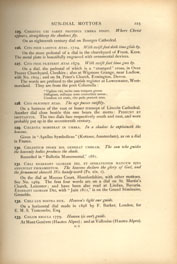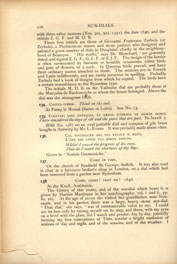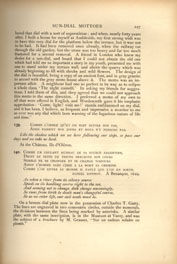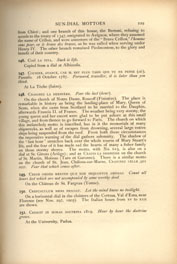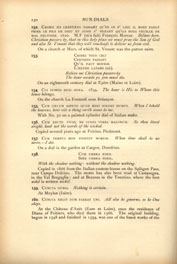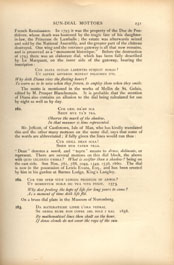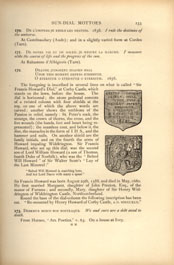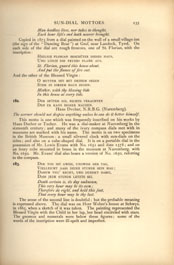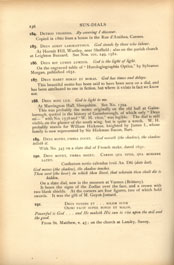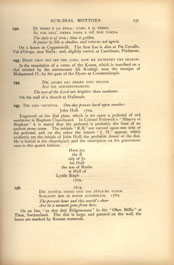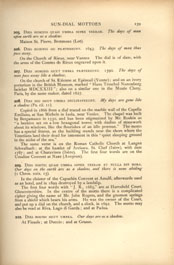Sun-Dial Mottoes (continued.)
| 102. | BREVIS HOMINUM VITA. Short is the life of man. On the dial which was formerly on the porch of Aberford Church, Yorkshire. It was removed when the church was rebuilt, and is now laid aside. The motto recalls the lines of Bernard de Morlaix:
"Hic breve vivitur, hic breve plangitur, hic breve fletur;
Here brief is the sighing, here brief is the crying, here brief is life; |
| 103. | BRIGHT SOL AND LUNA TIME AND TIDE DOTH HOLD. Over the church door at Towednack, Cornwall. |
| 104. |
BULLA EST VITA HUMANA. The life of man is a bubble. With nine other mottoes on a cross dial at Elleslie, near Chichester (see Nos. 329, 827, 841, 966, 1048, 1172, 1485, 1541, 1574). |
| 105. |
BY LIGHT FROM HEAVEN I MARK HOW DAYS DO DIE; These lines were written by the Rev. J. T. Jeffcock in 1861, and he intended to have them inscribed on the dial in the garden of the vicarage at Wolstanton, where he was then Vicar, but his intention was not carried into execution. |
| 106. |
The shadow falls under the rays (of the sun) at noontide, and until sunset is their sojourn. Alluding to the position of the dial which declines west, and therefore catches the sun's rays from midday to sunset. It is on a house at La Tour, the little capital of the Waldensian valleys of Piedmont, and is painted on the wall, the motto being in one corner. Copied in 1865. |
| 107. | CAPIT OMNIA NUSQUAM DEVIUS. [The sun] never swerving embraces all. Recorded in "Bulletin Monumental," 1878, but no locality given. |
| 108. | CARPE DIEM. Seize the (present) moment. The earliest dated example of this motto is at Cadder House, near |
Glasgow, where it appears with Nos. 443, 896, and the date 1698. It is on a vertical dial, dated MDCCXVII, on a house in High Street, Lewes, and on a horizontal dial at Brahan Castle, Ross-shire, dated 1794: and at Kings Conghton House, near Alcester, on a horizontal dial brought from Salford Priors, inscribed "John Clark, fecit 1742. Petworth." It was formerly on the church tower at Offchurch, Warwickshire (where the dial is painted with the sun's face, the gnomon acting as nose), with "William Snow, Churchwarden, 1795," but is now illegible. It is also at Burton Hastings, Warwickshire; in Overton churchyard, Flintshire, with Nos. 940, 1176, and the date 1803; and in 1855 it was inscribed on a circular erect dial painted in blue and gold on the gable of a modern wing, which was added in that year to the old Elizabethan mansion of Heslington Hall, near York. |
|
| 109. | CARPE DIEM, HORA ADEST VESPERTINA. Seize the present moment, the hour of evening is nigh. Upon the stone support of a dial at Tornaveen, near Torphins, Aberdeen. On the dial plate No. 72 is engraved. |
| 110. | CARPE, FUGIT. Seize it, – it flies. At Chinon (Indre et Loire), 1881. |
| 111. |
CARPE VIATOR LICET: SOL TENEBRAS DISSIPAT:
Traveller, thou mayest proceed: the sun dispels the darkness: Two dismantled sun-dials placed in a corner of the garden walls at Effingham Castle, Northumberland, bear these mottoes. |
| 112. | CAUTE CAVE MEDIO NE DESIT LUMINE LUMEN. – Take heed that light be not wanting at mid-day. Recorded in "Bulletin Monumental," 1883. |
| 113. | C'EST L'HEURE D'AIMER (DE SERVIR) DIEU. Now is the time to love (serve) God. At Quincieux; and on the Ecole des Frères, St. Siméon de Bressieux (Isère) respectively. |
| 114. | C'EST L'HEURE DE BIEN FAIRE. It is the hour for well-doing. On a dial erected by Lord Ilchester at Melbury Castle, Dorset. The dial is placed below a bay window, and the signs of the zodiac are engraved down either side of the face. A second motto (No. 632) is below the gnomon. The projecting bay extends to the top of the house, and has the appearance of a turret. It was built about 1890, when extensive additions were made to the house, the |
design being copied from an older part of the building dated circa 1400. The illustration is from a kodak photograph taken by Lady Muriel Fox Strangways. The same motto (114) is at Holmhurst, Sussex, inscribed by A. J. C. Hare, Esq.; at Erlesdene (formerly at The Beeches), Bowdon, Cheshire, inscribed by the late J. S debotham, Esq. It has been read at the Chartreuse, Auray (Morbihan); and in the South of France at Bozel (Savoy); Champagnier (Isère), dated 1849; Lentiel, dated 1862; Les Alberts (Hautes Alpes); Nice; and at Porto Maurizio, the words being slightly varied in some instances. |
||||||||||
| 115. |
Now is the time to live well, to repent, to be converted. These slightly varied mottoes are at Apprieu (Isère); at Tarascon; at La Rivière (Isère); and at the Hameau du Sabot at Vatilieu (Isère). |
|||||||||
| 116. | C'EST L'HEURE DE BOIRE. Now is the time for drinking. On an Inn at Libourne; and on a cabaret at Beaucroissant, dated 1796-1808. Also at La Murette (Isère). |
|||||||||
| 117. |
CELUI QUI DORT LA GRASSE MATINÉE
He who sleeps the morning through At La Tour du Pin (Isère). |
|||||||||
| 118. | CERTA MIHI MORS, INCERTA EST FUNERIS HORA. My death is certain, but the hour of my death is uncertain. Recorded in the "Bulletin Monumental," 1881. |
|||||||||
| 119. | CERTA RATIO, 1772. A sure reckoning. On Deighton Church, Yorkshire. |
| 120. | CETE MONTRE PAR SONOMBRE NOV S MONTRE QUE COME PASSE-LOMBRE PA SSENTN OSIOURS. (CETTE MONTRE PAR SON OMBRE NOUS MONTRE QUE COMME PASSE L' OMBRE PASSENT NOS JOURS.) This marker marks by its shadow that like a shadow our days pass away. The style divides the letters of the last word but one, of this curiously spelt and divided motto which dates from the eighteenth century, and is on the church at Argentières (Hautes Alpes). The first words of a Latin rendering, "Signat mon – " are also just visible. |
|||
| 121. |
CETTE OMBRE SOLAIRE EST À LA FOIS This solar shadow is at once the measure of time and the symbol of life. At Courmayeur. |
|||
| 122. |
Where charity is, there is fame; ensue the one and keep it, hope for the other. On the former convent of the Minimes, Vitry le François. |
|||
| 123. | CHEMINEZ TANDIS QUE VOUS AVEZ LA LUMIÈRE. 1668. Walk while you have the light. ה ב ד מ ה כ א ל מ ת ן ד צ ק ם ן ֙ ה The day is short and the work great. These two inscriptions, together with No. 1530, and a Greek motto now quite illegible, are on a dial on the church wall at Hatford, near Faringdon, Berks, just below the bell turret. The Hebrew line (which was ill cut and even in 1888 very nearly defaced) was from the Talmud. |
|||
| 124. | CHRISTUS SOLUS MIHI SALUS. Jo. Clerke. Christ alone is my salvation. Inscribed on the step of the base of a broken pillar at Ingoldswick, near Skegness. The pillar forms the gnomon, and the square base the dial. The hours are cut at the edge, with the date 1600. M.B. The pillar probably once formed the shaft of a cross. |
| 125. | CHRISTUS UBI PARET PROTINUS UMBRA FUGIT. Where Christ appears, straightway the shadows fly. On an eighteenth century dial on Bourges Cathedral. |
| 126. | CITO PEDE LABITUR ÆTAS. 1724. With swift foot doth time glide by. On the stone pedestal of a dial in the churchyard of Frant, Kent. The metal plate is beautifully engraved with ornamental devices. |
| 127. | CITO PEDE PRÆTERIT ÆTAS 1679. With swift foot time goes by. On a dial, the pedestal of which is a "stumped" cross, in Over Peover Churchyard, Cheshire; also at Wigmore Grange, near Ludlow, with No. 1604; and on St. Peter's Church, Ermington, Devon. The words are prefixed to the parish register at Loweswater, Westmoreland. They are from the poet Columella: "Vigilate viri, tacito nam tempora gressu |
| 128. | CITO PRÆTERIT ÆTAS. The age passes swiftly. On a buttress of the east or lesser transept of Lincoln Cathedral. Another dial close beside this one bears the motto: PEREUNT ET IMPUTANTUR. The two dials face respectively south and east, and were probably put up in the seventeenth century. |
| 129. | CŒLESTIA MONSTRAT IN UMBRA. In a shadow he explaineth the heavens. Given in "Apelles Symbolicus" (Kettner, Amsterdam), as on a dial in France. |
| 130. | CŒLESTIUM INDEX SOL GENERAT UMBRAM. The sun who guides the heavenly bodies produces the shade. Recorded in "Bulletin Monumental," 1881. |
| 131. | CŒLI ENARRANT GLORIAM DEI, ET OPERATIONEM MANUUM EJUS ANNUNTIAT FIRMAMENTUM. The heavens declare the glory of God, and the firmament showeth His handy-work (Ps. xix. I). On the dial at Moccas Court, Herefordshire, with other mottoes. See No. 1469. The first four words are on a dial on St. Martin's Church, Leicester; and have been also read at Lindau, Bavaria. ENARRANT GLORIAM DEI, with "Juin 1811," is on the Grand Séminaire, Grenoble. |
| 132. | CŒLI LUX NOSTRA DUX. Heaven's light our guide. On a horizontal dial made in 1898 by F. Barker, London, for E. M. S. Testcombe, Esq. |
| 133. | CŒLUM REGULA 1779. Heaven (is our) guide. At Mont Genèvre (Hautes Alpes); and at Vallouise (Hautes Alpes), |
with three other mottoes (Nos. 305, 501, 1591), the date 1840, and the initials Z. G. F. and M. D. B. These first initials are those of Giovanni Francesco Zarbula (or Zerbola), a Piedmontese mason and stone painter, who designed and painted a great number of dials in Dauphiné, chiefly in the neighbourhood of Briançon. "His works," says Dr. Blanchard, "are generally dated, and signed Z. G. F., G. Z. F., or Z. J. F. The design of the border is often surmounted by fantastic or heraldic ornaments, either birds and pots of flowers, or a cock. In Queyras birds prevail, and have their ordinary names attached to them. The mottoes are in French and Latin indifferently, and are rarely incorrect in spelling. Probably Zarbula had a book of designs from which he copied. The birds have a certain resemblance to the Byzantine type.
The initials M. D. B. on the Vallouise dial are probably those of the Marquise de Bardonnéche to whom the house belonged. Above the dial was the monogram
|
|||||||
| 134. | COGITA FINEM. Think on thy end. At Paray le Monial (Saône et Loire). See No. 75. |
||||||
| 135. |
COGITAVI DIES ANTIQUOS, ET ANNOS ÆTERNOS IN MENTE HABUI. With No. 1587 on an oval portable dial and compass of gilt brass bought in Antwerp by Mr. L. Evans. It was probably made about 1600. |
||||||
| 136. |
COL DISTINGUER DEL SOL VELOCE IL MOTO, Given in "Notizie Gnomoniche." |
||||||
| 137. | COME IN TIME. On the church of Bradfield St. George, Suffolk. It was also read in 1896 at a furniture broker's shop in London, on a dial which had been removed from a garden near Sydenham. |
||||||
| 138. | COME, LIGHT! VISIT ME! 1846. At the Knoll, Ambleside. The history of this motto, and of the sun-dial which bears it, is given by Harriet Martineau in her autobiography, vol. i and ii., pp. 80, 265. At the age of seven she visited her grandfather, near Newcastle, and in his garden there was a large, heavy stone sun-dial. "That dial," she says, "was of immeasurable value to me. I could see its face only by raising myself on its step, and there, with my eyes on a level with the plate, did I watch and ponder, day by day, painfully forming my first conceptions of Time, amidst a bright confusion of notions of day and night, and of the seasons, and of the weather. I |
| loved that dial with a sort of superstition; and when, nearly forty years after, I built a house for myself at Ambleside, my first strong wish was to have this very dial for the platform below the terrace, but it was not to be had. It had been removed once already, when the railway cut through the old garden, but the stone was too heavy and far too much fractured for a second removal. A friend in London who knew my desire for a sun-dial, and heard that I could not obtain the old one which had told me so important a story in my youth, presented me with one to stand under my terrace wall, and above the quarry which was already beginning to fill with shrubs and wild flowers. The design of the dial is beautiful, being a copy of an ancient font, and in gray granite to accord with the gray stone house above it. The motto was an important affair. A neighbour had one so perfect in its way as to eclipse a whole class, 'The night cometh.' In asking my friends for suggestions, I told them of this, and they agreed that we could not approach this motto in the same direction. I preferred a motto of my own to all that were offered in English and Wordsworth gave it his emphatic approbation: 'Come, light! visit me!' stands emblazoned on my dial, and it has been, I believe, as frequent and impressive a monitor to me as ever was any dial which bore warning of the fugacious nature of life and time." | |
| 139. |
COMME L'OMBRE QU'ICI ON VOIT SUIVRE NOS PAS, Like the shadow which we see here following our steps, so pass our days and we take no heed. At the Château, Ile d'Oléron. |
| 140. |
COMME UN COULANT RUISSAU DE SA SOURCE ARGENTINE,
As when a river from its silvery source On a bronze dial plate now in the possession of Charles T. Gatty. The lines are engraved in two concentric circles, outside the numerals, the divisions between the lines being marked by asterisks. A similar plate, with the same inscription, is in the Museum at Varzy, and was the subject of a brochure by M. Grasset, "Sur un cadran solaire en plomb." |
| 141. | CON L'ORE ANCO LA VITA. As the hours, so our life. Given in "Notizie Gnomoniche." |
| 142. | CONCITO GRADU. With hurried step. On the porch, and formerly on the tower, of Ruishton Church, Somersetshire. Also at South Ella. See No. 932. |
| 143. | CONCORDIA. 1715. FRATRUM. 1823. The love of brothers. On two complementary dials at Arvieux (Hautes Alpes). |
| 144. | CORRIGE PRÆTERITUM. Correct the past, direct the present, discern the future. Formerly in the Altmarkt at Dresden. The English version was placed on a horizontal dial made by F. Barker, London, in 1985. |
| 145. |
CORRO A QUEL DÌ CHE DEL SIGNOR LA SPADA
I haste to that day when God's almighty hand
QUESTA FIDA CHE FA LANCE CH'IO PORTO
This faithful shaft I bear one day shall trace These inscriptions are placed above two dials, which stand side by side on the cathedral wall of Chieri, in Piedmont. One of them also shows the meridians of the chief cities of the world. The motto is patriotic, and a literal translation of it is most difficult. It has puzzled not only good Italian scholars, but native Italians also. The above verses have been written for the present edition by B. Bentham Dickinson, Esq., of Rugby, and though he has used some poetical license in rendering such words as spada and risorto, the translation follows the idea of the original very closely, and is much better than any previous rendering. In the last edition we had only a literal translation of the mottoes. The word lance may be taken as a shortened form of lancetta – gnomon, dart, or small lance; possibly the gnomon is this instance was shaped as a weapon. Chieri is a few miles from Turin, on the left bank of the Po. It is an old town, but has suffered too much in the mediæval wars to retain many vestiges of antiquity. It has a round church of early Lombard architecture, which is now used as a baptistery. In its brighter days it was a free town, sending traders over half of Europe. It often changed its protectors: sometimes from choice, but more frequently form necessity; and at last gave its allegiance to the Counts of Savoy in 1347. The family of Balbo springs |
| from Chieri; and one branch of this house, the Bertoni, refusing to accede to the treaty of 1347, emigrated to Avignon, where they assumed the name of Crillon, and were ancestors of the "Brave Crillon," l'homme sans peur, or le brave des braves, as he was called when serving under Henry IV. The other branch remained Piedmontese, to the glory and benefit of their country. | |
| 146. | COSÌ LA VITA. Such is life. Copied from a dial at Albizzola. |
| 147. | COURIER, AVANCE, CAR IL EST PLUS TARD QUE TU NE PENSE (sic). Pascalis. 28 Octobre 1787. Forward, traveller, it is later than you think. At La Tèche (Isère). |
| 148. | CRAIGNEZ LA DERNIÈRE. Fear the last (hour). On the church of Notre Dame, Roscoff (Finistère). The place is remarkable in history as being the landing-place of Mary, Queen of Scots, when she came from Scotland to be married to the Dauphin, afterwards Francis II. of France. The weather being very stormy, the young queen and her escort were glad to be put ashore at this small village, and from thence to go forward to Paris. The church on which this melancholy motto is inscribed, has in it the memorials of many shipwrecks, as well as of escapes from drowning, several large votive ships being suspended from the roof. From both these circumstances the imperative warning of the dial gathers solemnity. The shadow of the "last hour" stretches back over the whole course of Mary Stuart's life, and the fear of it has made sad the hearts of many a fisher family on these stormy shores. The motto, with No. 615, is also on a dial at St. Girons (Ariège); and as CRAINS LA DERNIÈRE on the church of St. Martin, Moissac (Tarn et Garonne). There is a similar motto on the church of St. Jean, Châlons-sur-Marne, CRAIGNEZ CELLE QUI SUIT. Fear that which comes after. |
| 149. | CREDE OMNES MERITIS QUÆ NON SEQUANTUR AMISSAS. Count all hours lost which are not accompanied by some worthy deed. On the Château de St. Fargeau (Yonne). |
| 150. | CREPUSCULUM MENS NESCIAT. Let the mind know no twilight. On a horizontal dial in the cloisters of the Certosa, Val d'Ema, near Florence (see Nos. 297, 1005). The Italian hours from XV to XXII are shown. |
| 151. | CRESCIT IN HORAS DOCTRINA 1819. Hour by hour the doctrine grows. At the University, Padua. |
| 152. | CROIEZ ICI CRESTIENS PASSANT QU'EN CE ST LIEU IL NOUS FAULT PRIER LE FILS DU DIEU ET AUSSI ST VENANT QU'ILS NOUS VEUILLE DE MAL DELIVRER. 1620. M.F. (m'a fait) François Morcar. Believe here, Christian passers by, that in this holy place we must pray the Son of God and also St. Venant that they will vouchsafe to deliver us from evil. On a church at Murs, of which St. Venant was the patron saint. |
| 153. |
On an eighteenth century dial at Epire (Maine et Loire). |
| 154. | CUI DOMUS HUIC HORA. 1834. The hour is His to Whom this house belongs. On the church La Fontenil sous Briançon. |
| 155. | CUM CŒLUM ASPICIO QUAM MIHI SORDET HUMUS. When I behold the heavens, how vile a thing earth seems to me. With No. 50 on a painted cylinder dial of Italian make. |
| 156. | CUM RECTE VIVAS, NE CURES VERBA MALORUM. So thou livest aright, heed not the words of the wicked. Copied several years ago at Poirino, Piedmont. |
| 157. | CUM TEMPUS NON EXISTET MORIOR. When time shall be no more, – I die. On a dial in the garden at Cargen, Dumfries. |
| 158. | CUM UMBRA NIHIL With the shadow nothing: without the shadow nothing. Copied in 1866 from the Italian custom-house on the Splügen Pass, near Campo Dolcino. The motto has also been read at Castasegna, in the Val Bregaglia; and at Bezzeca in the Trentino, where the first nihil is written nichil. |
| 159. | CUNCTA DUBIA. Nothing is certain. At Meylan (Isère). |
| 160. | CUNCTA REGIT DUM PAREAT UNI. All else he governs, so he One obeys. At the Château d'Anêt (Eure et Loire), once the residence of Diana of Poitiers, who died there in 1566. The original building, begun in 1548 and finished in 1554, was one of the finest works of the |
French Renaissance. In 1793 it was the property of the Duc de Penthièvre, whose death was hastened by the tragic fate of his daugthter-in-law, the Princess de Lamballe; the estate was afterwards seized and sold by the National Assembly, and the greater part of the château destroyed. One wing and the entrance gateway is all that now remains, and is preserved as a "monument historique." Before the destruction of 1793 there was an elaborate dial, which has been fully described by Le Marquant, on the inner side of the gateway, bearing the inscription:
CUR DIANA OCULIS LABENTES SUBJICIT HORAS?
Why doth Diana view the fleeting hours? The motto is mentioned in the works of Mellin de St. Gelais, edited by M. Prosper Blanchemain. It is probable that the mention of Diana also contains an allusion to the dial being calculated for use by night as well as by day. |
|
| 161. |
Mr. Jeffcott, of Castletown, Isle of Man, who has kindly translated this and the other many mottoes on the same dial, says that some of the words are abbreviated; if fully given the lines would run thus: CUR GEILL DEAN SCAA! "Dean" denotes a mark, and "tayrn" means to draw, delineate, or represent. There are several mottoes on this dial block, the above with QUID CELERIUS UMBRA? What is swifter than a shadow? being on the east side. See Nos. 761, 788, 1049, 1349, 1536, 1660. The dial is now in the possession of Lewis Evans, Esq., and has been erected by him in his garden at Barnes Lodge, King's Langley. |
| 162. |
CUR TIBI SPEM VITÆ LONGOS PRODUCIS IN ANNOS?
Why dost prolong the hope of life for long years to come? On a brass dial plate in the museum of Nuremberg. |
| 163. |
DA MATEMATICHE LINEE L'ORA VEDRAI,
By mathematical lines thou shalt see the hour, |
On a dial painted on the wall of a house at Caprile, Venetia, bearing the face of the sun on a blue ground. |
|
| 164. |
DAMMI IL SOLE E DEL GIORNO L'ORA È CERTA; Give me the sun, and the hour of the day is certain; of man alone is the last hour uncertain. On the church at Arola, a village between Lago d'Orta and Val Sesia. |
| 165. | DANS CE JARDIN, TOUT SE RENCONTRE This garden is a common meeting-place for all, except for flower and shade. If our manners become irregular, we can at any rate keep our watches regular. Lines by Jacques Delille on, or for, the sun-dial in the Palais Royal Garden, Paris. |
| 166. | DATAM DO. I give what hath been given, I deny what hath been denied. At a village near Fénestrelles. |
| 167. | DAY GIVES PLACE TO NIGHT; LIFE SOON ENDS IN DEATH; AND TIME WILL SOON BE SWALLOWED UP IN VAST ETERNITY.
This dial belongs to And. Cowan. In the grounds of Amisfield, near Lochmaben, Dumfriesshire. |
| 168. | DAY UNTO DAY UTTERETH SPEECH, AND NIGHT UNTO NIGHT SHOWETH KNOWLEDGE. 1856. Psalm xix. 2. The dial was made by the late Henry Grange, Esq., of Grange, Barrowstonness, Linlithgowshire. |
| 169. | DAYS AND AGES ARE BUT AS A SHADOW OF THE ETERNAL; BUT THEIR USE, O MAN, DETERMINES THY FUTURE WEAL OR WOE.
ΈΛΕϒΣΟΝΤΑΙ
ΓΑΡ
ΉΜΕΡΑΙ
Κ. Τ. Λ. These mottoes, with No. 1008, were formerly on the keep of Carlisle Castle, just above the magazine, but are now obliterated. When last examined, in 1882, the dial was a wreck, and the last remains of it have now probably disappeared. |
| 170. | DE L'UNIVERS JE RÈGLE LES DESTINS. 1838. I rule the destinies of the universe. At Castelnaudary (Aude); and in a slightly varied form at Cordes (Tarn). |
| 171. | DE NOTRE VIE ET DU SOLEIL JE MESURE LA MARCHE. I measure alike the course of life and the progress of the sun. At Rabastens d'Albigeois (Tarn). |
| 172. | DEATHE JUDGMENT HEAVEN HELL The foregoing is inscribed in several lines on what is called "Sir Francis Howard's Dial," at Corby Castle, which stands on the lawn, before the house. The dial is horizontal; the stone pedestal consists of a twisted column with four shields at the top, on one of which the above words are carved; another shows the emblems of the Passion in relief, namely: St. Peter's cock, the scourge, the crown of thorns, the cross, and the five wounds (the hands, feet and heart being represented); the seamless coat, and below it, the dice, the manacles in the form of I H S., and the hammer and nails. On another shield are the family initials, and on the fourth the arms of Howard impaling Widdrington. Sir Francis Howard, who set up this dial, was the second son of Lord William Howard (a son of Thomas, fourth Duke of Norfolk), who was the "Belted Will Howard" of Sir Walter Scott's "Lay of the Last Minstrel:" "Belted Will Howard is marching here, Sir Francis Howard was born August 29th, 1588, and died in May, 1680. He first married Margaret, daughter of John Preston, Esq., of the manor of Furness; and secondly, Mary, daughter of Sir Henry Widdrington of Widdrington Castle, Northumberland. Round the base of the dial-column the following inscription has been cut. "Re-mounted by Henry Howard of Corby Castle, A.D. MDCCCXLII." |
| 173. | DEBEMUR MORTI NOS NOSTRAQUE. We and ours are a debt owed to death. From Horace, "Ars Poetica," v. 63. On a house at Ivry. |
| 174. | DEFECERUNT SICUT FUMUS DIES NOSTRI. Our days are consumed like smoke (Ps. cii. 3). Recorded in "Bulletin Monumental." 1883. |
| 175. | DEFICIT SOL, NEMO RESPICIT. 15 Maggio, 1839. None turns to look when clouds the sun conceal. Seen in 1860 on the wall of the Italian Custom House at Fornasette, between Lugano and Luino, together with No. 224. |
| 176. |
DEL CERCHIO IL PIANO ABBRACCIA UN PUNTO SOLO We cannot give a satisfactory translation of this motto, although the literal meaning of each word is quite simple. Possibly there was some emblem attached to the dial of which we have not been told, and which would explain the text. It is on the church at Tesero, Val Fiemme, Tyrol. |
| 177. |
DELLA VITA IL CAMMIN L'ASTRO MAGGIORE
The glorious orb of day with breathless speed Copied in 1867, with No. 331, from the wall of the former convent della Quiete, afterwards a girls' school, near Florence. |
| 178. |
On a church at Varazze, Riviera di Levante. |
| 179. | DEO SOLI GLORIA. To God alone be glory. On a church at Sierre, in the Canton du Valais. |
| 180. |
This dial is engraved on a slab of green marble let into the wall above the door of the Maison Voiron, in the village of Le Rosier, Val des Prés (Hautes Alpes). Near it is a stone with the letters VV. H. M. 1809. The united Vs stand for Viva Viva. The custom of introducing these letters into inscriptions came from Italy, and was much practised about the time of the Revolution. Inscriptions such as VV La nation, VV La loi, etc., were often to be seen. |
| 181. |
DER MENSCH LEBT SO DAHIN UND NIMT ES NICHT IN ACHT, |
Man heedless lives, nor takes to thought, Copied in 1873 from a dial painted on the wall of a small village inn (the sign of the "Dancing Bear") at Graf, near Landeck, Tyrol. On each side of the dial are rough frescoes, one of St. Florian, with the inscription:
And the other of the Blessed Virgin:
|
|
| 182. | DER SPÖTER SOL NICHTS VERACHTEN The scorner should not despise anything unless he can do it better himself. This motto is one which was frequently inscribed on his works by Hans Ducher or Tucher. He was a dial-maker at Nuremberg in the sixteenth century; and many of the ivory compass dials met with in museums are marked with his name. The motto is on two specimens in the British Museum: a small silvered clock with sun-dials on the sides; and also on a cube-shaped dial. It is on a portable dial in the possession of Mr. Lewis Evans with No. 1651 and date 1578; and on an ivory cube mounted in brass in the museum at Nuremberg, with No. 1650. Mr. Evans' dial also bears a version of No. 1650, referring to the compass. |
| 183. |
DER TOD IST GWISS, UNGWISS DER TAG,
Death certain is, its day unknown, The sense of the second line is doubtful; but the probable meaning is expressed above. The dial was on Herr Weber's house at Schwyz, in 1865, when a sketch of it was taken. The painting represented the Blessed Virgin with the Child in her lap, her head encircled with stars. The gnomon and numerals were below these figures; some of the words of the inscription were ill-spelt and imperfect. |
| 184. | DETEGO TEGENDO. By covering I discover. Copied in 1860 from a house in Rue d'Antibes, Cannes. |
| 185. | DEUS ADEST LABORANTIBUS. God stands by those who labour. At Hermit Hill, Wortley, near Sheffield; also on the parish church at Leighton Buzzard. See Nos. 101, 249, 1582. |
| 186. | DEUS EST LUMEN LUMINIS. God is the light of light. On the engraved table of "Horologiographia Optica," by Sylvanus Morgan, published 1652. |
| 187. | DEUS HABET HORAS ET MORAS. God has times and delays. This beautiful motto has been said to have been seen on a dial, and has been attributed to one in fiction, but where it exists in fact we know not. |
| 188. | DEUS MIHI LUX. God is light to me. At Marrington Hall, Shropshire. See No. 1394. This was probably the motto originally on the old hall at Gainsborough, quoted in the history of Gainsborough, of which only "Deus mi – " with No. 1536 and "W. H. 1600," was legible. The dial is still visible on the plaster of the south wing, but is quite a wreck. W. H. probably stands for William Hickman, knighted by James I., whose family is now represented by Sir Hickman Bacon, Bart. |
| 189. | DEUS MOVET, UMBRA DOCET. God moveth (the shadow), the shadow telleth it. With No. 345 on a slate dial of French make, dated 1631. |
| 190. | DEVS MOVET, VMBRA DOCET. CERNIS QVA VIVIS, QVA MORIERE LATET. Confectum tertio calendas ivnii An. Dñi (date lost).
God moves (the shadow), the shadow teaches. On a slate dial, now in the museum at Vannes (Brittany). It bears the signs of the Zodiac over the face, and a crown with two blank shields. At the corners are four figures, two of which hold swords. It was the gift of M. Guyot-Jomard. |
| 191. | DEUS POTENS ET . . . SOLEM SUUM Powerful is God . . . and He maketh His sun to rise upon the evil and the good. From St. Matthew, v. 45; on the church at Landry, Savoy. |
| 192. |
DI FERRO È LO STILO; D'ORO È IL TEMPO.
The style is of iron; time is golden, On a house at Ceppmorelli, The first line is also at Pie Cavallo, Val d'Oropa, near Biella; and, slightly varied, at Cambiano, Piedmont. |
||
| 193. | DIDST THOU NOT SEE THE LORD, HOW HE EXTENDED THY SHADOW. Is the translation of a verse of the Koran, which is inscribed on a dial erected by the astronomer Ali Kushaji, near the mosque of Mohammed II., by the gate of the Dyers at Constantinople. |
||
| 194. | DIE AUGEN DES HERRN SIND HELLER The eyes of the Lord are brighter than sunbeams. On the wall of a church at Hallstadt. |
||
| 195. |
DIE DIES TRUDITUR. One day presses hard upon another.
Engraved on the dial plate, which is set upon a pedestal of red sandstone in Bispham Churchyard. In Colonel Fishwick's "History of Bispham" it is stated that the pedestal is probably the base of an ancient stone cross. The initials "R.B." are carved upon one side of the pedestal, and on the other the letters "J.H." appear, which evidently are the initials of John Hull, the probable donor of the dial. He is buried in the churchyard, and the inscription on his gravestone runs in this quaint fashion:
|
||
| 196. |
On an Inn, "zu den drei Eidgenossen" in the "Ober Bälliz" at Thun, Switzerland. The dial is large, and painted on the wall, the hours are marked by Roman numerals. |
| 197. | DIE SONNE SCHEINET ÜBERALL. The sun shines everywhere. In a garden on the banks of the Lake of Lugano. |
| 198. |
DIE ZEIT DIE STUND WIE AUCH DER TAG LAUFT SCHNELL DAHIN
The time the hour and eke the day, swiftly pass away: On a perpetual calendar of brass, in Mr. L. Evans's collection. |
| 199. | DIEM DIMETIOR UMBRA. I measure out the day by my shadow. On Maison Renil, Albi (Tarn). |
| 200. | DIES AFFERT MULTA. The day brings with it many things. This inscription was cut on a dial, the work of an ingenious and well educated man for his time, named Daniel Rose, who placed it over the doorway of his cottage house called "Shutts," near Ashopton in Derbyshire. He was the clerk of Derwent Chapel. and was also a schoolmaster and dial maker. It is said that he carved the dials in a soft slate stone during school-time with a penknife: the dials both in Derwent Churchyard (No. 749) and at the Hall (Nos. 24, 1536) are specimens of his skill. |
| 201. | DIES DIEM DOCET: DISCE. One day telleth another, learn. A block of stone with four dial faces placed over the porch of the old church at Barmston near Bridlington, Yorkshire, was thus inscribed. The letters, when sketched some thirty years ago, were much defaced. The motto was probably suggested by Ps. xix. 2. "One day telleth another," or, as in the Bible version, "Day unto day uttereth speech." |
| 202. | DIES DIMETIOR UMBRIS. I measure out the days by the shadows. Given in "Notizie Gnomoniche." It is also on a dial at Tarascon, but is imperfectly spelt. |
| 203. | DIES EJUS SICUT UMBRA PRÆTEREUNT. 1863. His time passeth away like a shadow. – Ps. cxliv. 4. On a church by the Grand Canal, Venice: on the Ecole des Beaux Arts, Paris (formerly the Cloister of the Convent of the "Petits Augustins"). "La perte de la vie est imperceptible, c'est l'aiguille du cadran que nous ne voyons pas aller." – Mme. de Sévigné. |
| 204. | DIES FUGIT SICUT UMBRA. The day fleeth like a shadow. At Cluny (Saône et Loire); and as DIES SICUT UMBRA FUGIT at Niozelle. |
| 205. | DIES HOMINIS QUASI UMBRA SUPER TERRAM. The days of man upon earth are as a shadow. Maison St. Pierre, Bretmoux (Lot). |
| 206. | DIES HOMINIS SIC PRÆTEREUNT. 1643. The days of man thus pass away. On the Church of Rieux, near Vannes. The dial is of slate, with the arms of the Comtes de Rieux engraved upon it. |
| 207. | DIES HOMINIS SICUT UMBRA PRÆTEREUNT. 1590. The days of man pass away like a shadow. On the church of St. Etienne at Epineuil (Yonne); and on an ivory portarium in the British Museum, marked "Hans Troschel Nuremberg faciebat MDCXXIII"; also on a similar one in the Musée Cluny, Paris, by the same maker, dated 1627. |
| 208. | DIES MEI SICUT UMBRA DECLINAVERUNT. My days are gone like a shadow (Ps. cii. II). Copied in 1866 from a dial traced on the marble wall of the Capella Emiliana, at San Michele in Isola, near Venice. The chapel was built by Bergamasco in 1530, and has been stigmatized by Mr. Ruskin as "a beehive set on a low hexagonal tower, with dashes of stonework about its windows, like the flourishes of an idle penman." The motto has a special fitness, as the building stands near the shore where the Venetians land their dead for interment in this "quiet sleeping ground in the midst of the sea." The same verse is on the Roman Catholic Church at Langen Schwalbach; at the hamlet of Arcisses, St. Chef (Isère), with date 1787; and at Charavines (Isère). The first four words are on the Ursuline Convent at Nant (Aveyron). |
| 209. | DIES NOSTRI QUASI UMBRA SUPER TERRAM ET NULLA EST MORA. Our days on the earth are as a shadow, and there is none abiding (I Chron. xxix. 15). In the cloister of the Capuchin Convent at Amalfi, afterwards used as an hotel, and in 1899 destroyed by a landslip. The first four words with "J. R., 1685," are at Haresfield Court, Gloucestershire. In the centre of the motto there is a complicated cipher giving the name of Mr. John Rogers, and the gnomon springs from a shield which bears his arms. He was the owner of the Court, and put up a dial on the church, and a clock, in 1692. The motto may also be read at Riva, Lago di Garda; and at Padua. |
| 210. | DIES NOSTRI SICUT UMBRA. Our days are as a shadow. At Fiesole; at Duccio; and at Grasse. |
| 211. |
On a west declining dial at Lawford Hall, near Manningtree. The motto is in the form of a scroll, painted on stucco; above it is the date 1583, and below 1867. Edward Waldegrave was living at Lawford Hall in 1583, and no doubt he erected the dial. The property remained in the possession of his family until 1621, when it passed into other hands. In 1867 the house was bought by Francis Nichols, Esq., and he had the dial restored exactly in its original form. |
|||||||
| 212. |
God saith that He hath in the heavens, stars which mark the years, the seasons, the months, the holy days, and days of the year. The sun and moon do that which has been commanded them, but we transgress the law of the Lord. The above inscriptions are on two dials on a school belonging to the Frères Chrétiens at Issy, near Paris. A Latin version of the second is at Notre Dame, St. Affrique (Aveyron). See No. 1232. |
|||||||
| 213. | DIEU PROTGE (sic) LA FRANCE. God protect France. At Charnècles (Isère). |
|||||||
| 214. |
God Who guides the glittering sun in its long course, makes morning sweeter by its first radiance, and likewise makes the burning noontide. At La Croiza (Hautes Alpes). |
|||||||
| 215. | DIEU SOIT BÉNI. 1873. Blessed be God. At Brunissard (Hautes Alpes); and St. Clair (Isère). |
|||||||
| 216. | DIGITUS DEI DUCET ME. 1859. The finger of God will lead me. With No. 1065, on the church, Villeneuve sur Vère (Tarn). |

